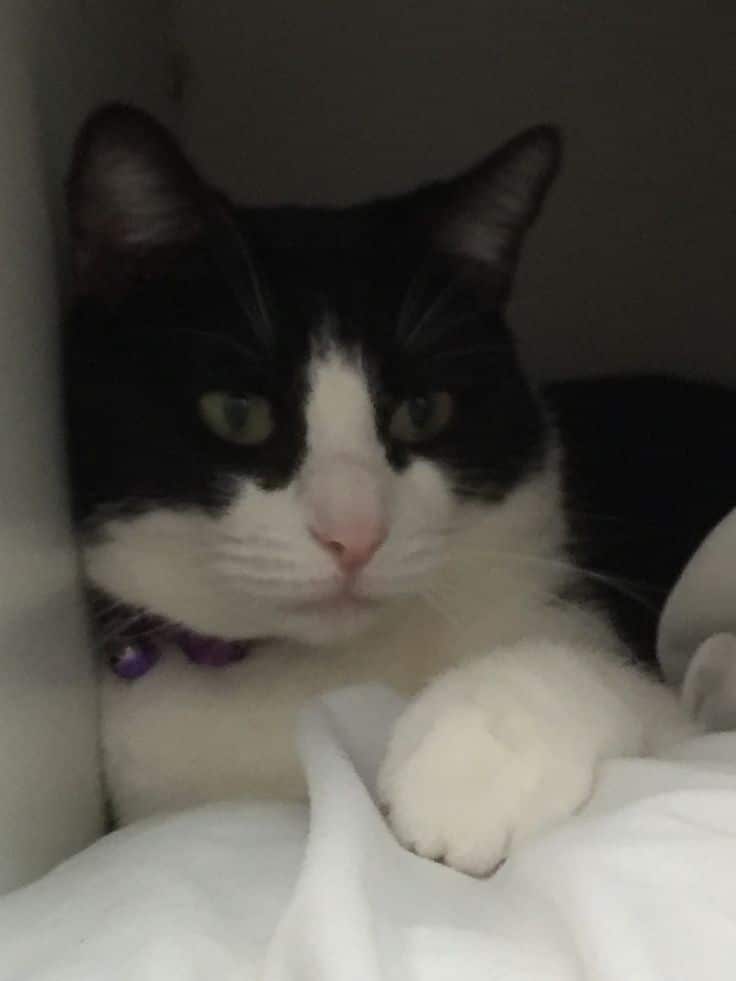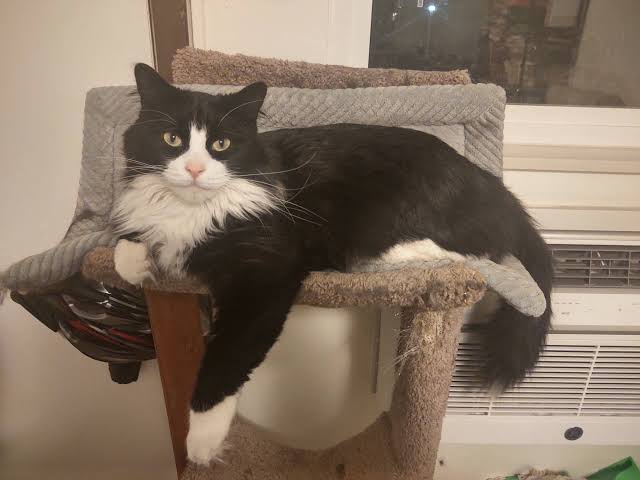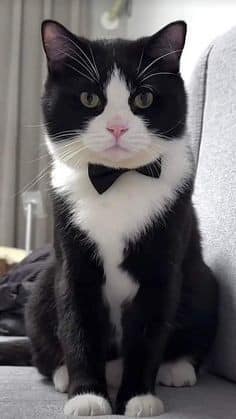If you’ve ever admired a cat with sharp black-and-white markings and wondered, “What is a tuxedo cat?”—you’re in the right place.
As a long-time cat parent, I understand how confusing cat coat patterns can be, especially when it comes to recognizing and differentiating between them. There are so many cat coat color variations, each with their own unique charm and characteristics. From the classic tabby with its stripes and swirls, to the sleek solid-colored cats or the striking tortoiseshells, it can be a challenge to identify the specific patterns. Understanding these variations can help deepen the connection with your feline friend and may even give insight into their genetics or personality traits.
Tuxedo cats are known for their elegant, formal-looking coats, but there’s so much more to these felines than just their appearance.
In this post, we’ll explore everything you need to know about tuxedo cats, including their unique coat patterns, personality traits, and whether they might be the perfect fit for your home.
Let’s get started and discover what makes tuxedo cats so special!
Table of Contents
What Is a Tuxedo Cat?

A tuxedo cat is a cat with a striking black-and-white (or sometimes gray-and-white) coat that resembles formalwear, like a tuxedo.
This bicolor pattern typically includes a black body with white markings on the face, chest, paws, and belly. Sometimes, you might even spot a black mark on the throat that looks like a bow tie!
How Do I Know If My Cat Is a Tuxedo Cat? Common Tuxedo Cat Markings
You can identify a tuxedo cat by looking for certain key markings. Here’s what to look for:
- White chest and belly – The white fur covers the chest and belly, creating the signature tuxedo look.
- White feet and legs – Tuxedo cats often have white “mittens” or “boots” that can extend up their legs.
- Facial markings – Some have white on their nose or chin, and many even sport a “mustache” marking!
- Other white spots – You might also notice small white patches on the tail or around the chin.

Tuxedo cats typically have less than 40% of their coat in white, with the rest of the body being primarily black. Sometimes, their white markings even form a “bow tie” shape on the throat, adding to their dapper appearance.
If your cat has these distinct patterns, chances are you’ve got yourself a tuxedo cat! 😸
History and Origins of Tuxedo Cats
Tuxedo cats have been around for thousands of years, with their striking black-and-white coats possibly dating back to ancient Egypt. In fact, about 70% of the cats depicted in Egyptian tomb paintings are believed to have been tuxedo cats. This suggests that tuxedos held a special place in Egyptian society, revered not just for their beauty but perhaps for their symbolic importance as well.

These ancient depictions highlight how long tuxedo cats have been admired by humans, making them a timeless and beloved part of cat history.
Tuxedo Cat Breeds: Who Wears the Coat?
While tuxedo cats aren’t a specific breed, many popular breeds can sport this stylish black-and-white pattern. Here are some common breeds known to feature tuxedo markings: For example, the American Shorthair and British Shorthair breeds often showcase the classic tuxedo look. Additionally, breeds like the Maine Coon can also have the distinctive black mitted cat with white paws appearance. These markings give the cats an elegant and formal look, making them stand out in any feline crowd. The tuxedo look is just one of several common bicolor cat patterns, which can vary in terms of how the black and white are distributed across the cat’s body. Some cats may have more white around their faces, chest, or belly, while others might display a more symmetrical split between the two colors. Regardless of the pattern, these dapper cats often exude a charm and sophistication that’s hard to ignore.
- American Shorthair
- British Shorthair
- Domestic Shorthair and Domestic Longhair
- Maine Coon
- Persian
- Turkish Angora
- Siberian
- Manx
- Ragdoll
- Scottish Fold
- Cornish Rex and Devon Rex
- American Curl
- Norwegian Forest Cat
No matter the breed, they always know how to stand out! 😸
Mixed Breed Tuxedo Cats
When tuxedo cats are mixed with other breeds, their patterns can become even more unique.
for example :
Tuxedo Cat and Maine Coon Mix: This mix often results in a large, fluffy cat with the signature tuxedo black-and-white markings. These cats tend to be friendly and sociable, inheriting both the Maine Coon’s easy-going nature and the tuxedo cat’s charm.

Tuxedo Cat and Orange Cat Mix: Mixing a tuxedo cat with an orange cat can produce interesting color combinations. You might see a blend of orange patches alongside the classic tuxedo black-and-white coat, giving your cat a one-of-a-kind appearance.

Mixed breed tuxedo cats offer a fun variety of markings and temperaments, depending on the combination!
Tuxedo Cat Personality: A Class of Their Own
While a tuxedo cat’s personality often depends on their breed, certain traits are consistently reported by owners. Just like any other cat, their temperament is influenced by their individual genetics, upbringing, and breed characteristics.
However, tuxedo cats seem to stand out with some unique quirks and charms that make them memorable companions.
Tuxedo cat owners often report the following about their cats’ personalities:

- Affectionate and Social: Many tuxedo cats are especially friendly, bonding well with humans. They love attention and tend to seek out companionship, making them perfect for those looking for a social pet.
- Intelligent and Playful: Tuxedo cats are known for their intelligence. They learn tricks quickly and enjoy engaging with interactive toys, staying curious and active throughout the day.
- Confident and Quirky: These cats often display confident, sometimes mischievous behavior. Their quirky nature leads them to explore their surroundings and get into playful antics, keeping their owners entertained.
Tuxedo Cat Size
Size Varies by Breed
Because tuxedo cats can be found in a variety of breeds, their size and weight differ significantly. For instance, a tuxedo Domestic Shorthair typically weighs between 6 to 10 pounds, while a Maine Coon tuxedo cat can be much larger—reaching up to 18-20 pounds.
Tuxedo Cat Healthy Weight : Average Weight Range
In general, tuxedo cats weigh anywhere from 6 to 20 pounds, depending on their breed and genetics. The variation in weight largely reflects the diversity of breeds that can exhibit the tuxedo pattern.
Physical Build
The build of a tuxedo cat is also determined by its breed. For example:
Maine Coon tuxedo cats are known for their larger size and long, fluffy coats.
British Shorthair tuxedo cats tend to have a stockier build with dense, short fur.
Each tuxedo cat’s size and physical traits are closely tied to their breed, adding to their unique appeal. Some tuxedo cats may have sleek, muscular bodies, while others may be more compact and sturdy, depending on their lineage. Interestingly, several breeds, including domestic shorthairs and Maine Coons, can exhibit the distinctive coloration pattern, which cats wear tuxedo coats. This characteristic black-and-white appearance only enhances their charm, making them a favorite among cat enthusiasts worldwide.
How Do Tuxedo Cats Get Their Coat Patterns?
Tuxedo cat coats are the result of the white spotting gene, also known as the piebald gene. This gene controls how pigment cells are distributed across the cat’s body during development. It prevents pigment from forming in certain areas, leading to the white patches typically seen on the chest, paws, and face. The extent of the white fur depends on how strongly the gene is expressed, which is why some tuxedo cats have more or less white than others.

On a genetic level, tuxedo cats often carry one dominant and one recessive copy of the white spotting gene, represented as Ss. This combination results in the classic tuxedo appearance with balanced black-and-white fur. Cats with two recessive copies (ss) may have only a few white hairs, while those with two dominant copies (SS) will have more extensive white patches covering larger parts of their body.
Tuxedo Cat Health: What to Watch For
Tuxedo cats don’t have any health concerns specifically tied to their coat pattern. However, like all cats, their overall health is influenced by the breed they belong to. For example, a tuxedo Maine Coon may be more prone to hip dysplasia, while a tuxedo Persian could be at risk for respiratory issues.
To ensure your tuxedo cat stays healthy, it’s important to:
- Keep up with regular vet visits to monitor for any breed-related conditions.
- Stay informed about potential genetic risks linked to your cat’s breed.
- Maintain a balanced diet and provide plenty of exercise to support long-term health.
Being proactive about veterinary care and monitoring for specific health concerns will help your tuxedo cat live a long, healthy life! Regular check-ups and preventative measures can catch potential issues early, ensuring your feline friend stays in optimal health. By maintaining a nutritious diet, providing mental and physical stimulation, and addressing health needs promptly, you can make a significant difference in their overall well-being. Understanding how long tuxedo cats live often depends on these factors, with proper care allowing them to reach an impressive lifespan of 15 years or more.
Are Tuxedo Cats the Right Fit for You?
If you’re seeking a cat that is affectionate, intelligent, and playful, a tuxedo cat could be an excellent choice. Their friendly personalities often make them great companions for families or individuals. However, it’s important to remember that their behavior and needs will vary based on their breed. When considering adopting a tuxedo cat, it’s important to do research on the specific breed to understand their temperament and any special requirements they may have. Identifying tuxedo cat breeds may involve looking for specific physical characteristics or consulting with a veterinarian or cat specialist. By knowing the specific breed, you can better understand the cat’s personality traits and any potential health or grooming needs they may have.
Before adopting a tuxedo cat, be sure to research the specific breed to ensure their temperament and care requirements align with your lifestyle. By doing so, you’ll be prepared to provide the best environment for your new feline friend!
